Last Updated on March 21, 2023
Did you know in 2018, the EPA estimated 13 million tons of clothing and footwear was produced? Of that, it’s estimated that the amount of clothing and footwear recycled was only 1.7 million tons. The rest was landfilled or combusted with energy recovery.
The reason these stats matter is because many of the clothes we’re tossing out can be repaired. For example, if you have a missing button on your favorite blouse, you can simply learn how to sew a button, instead of replacing it.
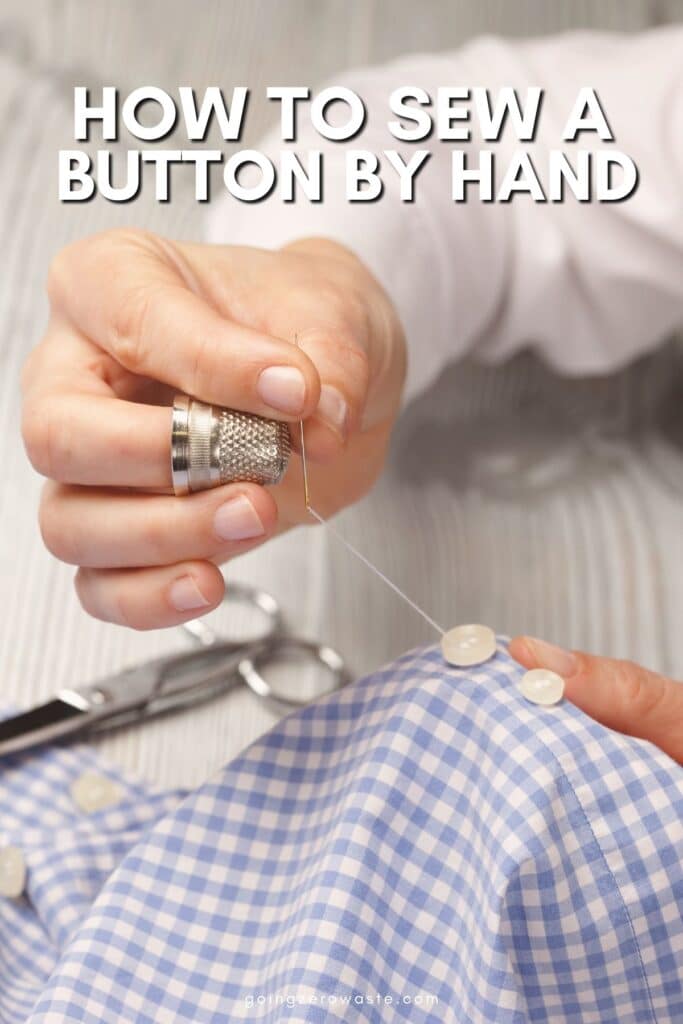
Unfortunately, many people don’t know how to repair their items due to clever marketing techniques designed to promote disposability.
Fast fashion is a huge part of this: They pump out low quality goods at high quantities that easily rip or tear, or simply get outdated by new trends. It’s called “planned obsolescence”, aka producing consumer goods that rapidly become obsolete and require replacing.
However, learning some easy fixes for your clothes can help prolong their life, keep them out of landfill, and break the mass consumption cycle. Here’s how to sew a button, and some other easy fixes for your garments.
Table of Contents
how to mend your clothing
Mending your clothing is one of the most zero waste skills you can learn. That’s because when we mend a clothing piece, it prolongs the garment’s life. This keeps it out of the landfill and avoids having to replace it, which saves resources.
To mend your clothes, you should have a sewing machine or a sewing kit handy. For the sake of simplicity, most of the tutorials below can be done by hand.
I suggest going to a craft store to pick up some supplies, or checking if you can borrow any mending supplies from a loved one. Chances are your grandmother may have a nice stash of sewing supplies you could borrow from.
Here are some mending supplies you should keep on hand:
- Various buttons
- Sewing needles
- Sewing thread
- Darning mushroom
- Scissors
- Mixed fabric pieces
- Ruler
- Pins
- Seam ripper
- Embroidery thread
You can store all of these in an upcycled tin, glass jar or container of your choice. Something small and portable is great for on the go mends.
By investing in your wardrobe, you will ensure your favorite pieces last longer. This is a radical act of care in a fast fashion system that thrives on disposal culture.
For more mending tips, be sure to check out my blog post 4 Things You Should Know How to Repair.
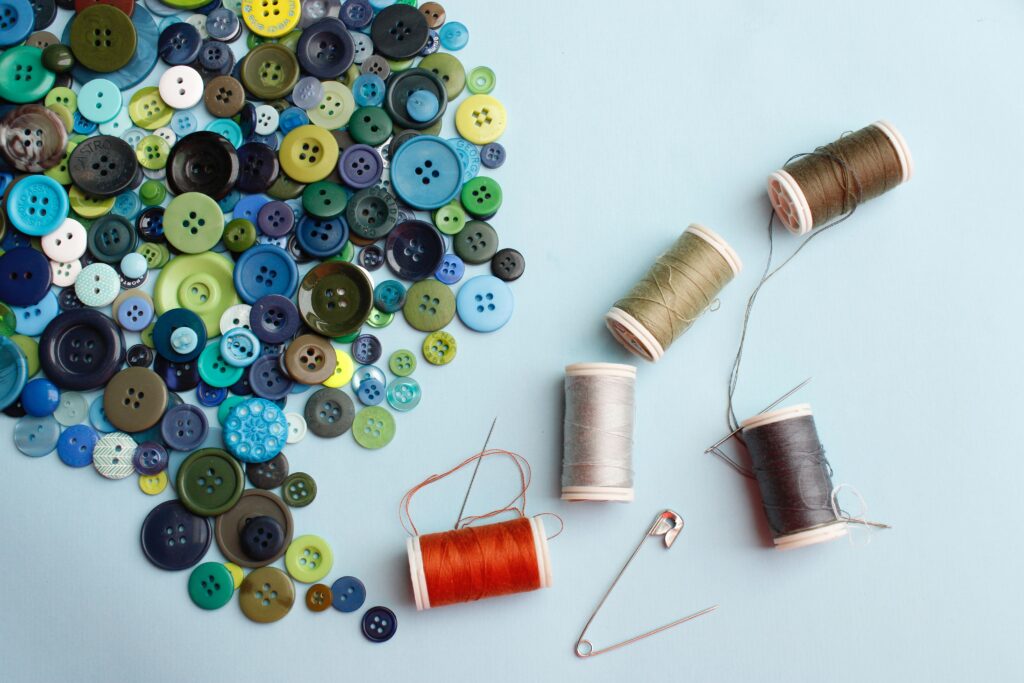
how do you hand sew a button step by step?
To hand sew a button step by step, you will first need to gather some supplies. It’s also good to set aside some time so you don’t have to rush.
Materials needed:
- Button
- Needle
- Thread
- Scissors
- Straight pin or toothpick
Directions:
1. Select an appropriate thread and button for your clothing. Check to see if extra buttons came with your garment first.
2. Cut a suitable length of thread with scissors. 12-18inches is generally enough. Thread and not needle.
3. First off, if you’re replacing a button, look for tiny holes left by the previous button. Put your new button there. Position the button and check to make sure it aligns with buttonhole.
4. Make your first stitch by inserting the needle into the back of the fabric (where the knotted end won’t show) and through one of the holes in the button. Be sure to pull the thread completely through on each stitch to keep it from bunching up.
5. Take a pin or a toothpick and center it on top of the button. For now, hold the pin in place with your finger.
6. Insert the needle through the next hole, into the fabric, and all the way through. This stitch will now hold the pin in place.
7. Insert the needle back up through the fabric and into the first hole. If you have a four-hole button, stitch up through a new hole. The thread will look kind of like an “X”. Pull the thread completely through.
8. Keep repeating these stitches until the button is secure. This typically takes 8 complete stitches.
9. On your last stitch, end with a double knot of the back side of the fabric.
10. Cut the excess thread and remove the pin. Gently pull up on the button to create space for the fabric.
how long does it take to sew a button?
It doesn’t take long to sew a button. If you follow the simple steps listed above, you’ll be able to sew your button in ten minutes or less.
5 other mending techniques you should know
Alongside how to sew a button, there are some other easy fixes for your clothing you should learn. Knowing any one of these can help salvage a garment.
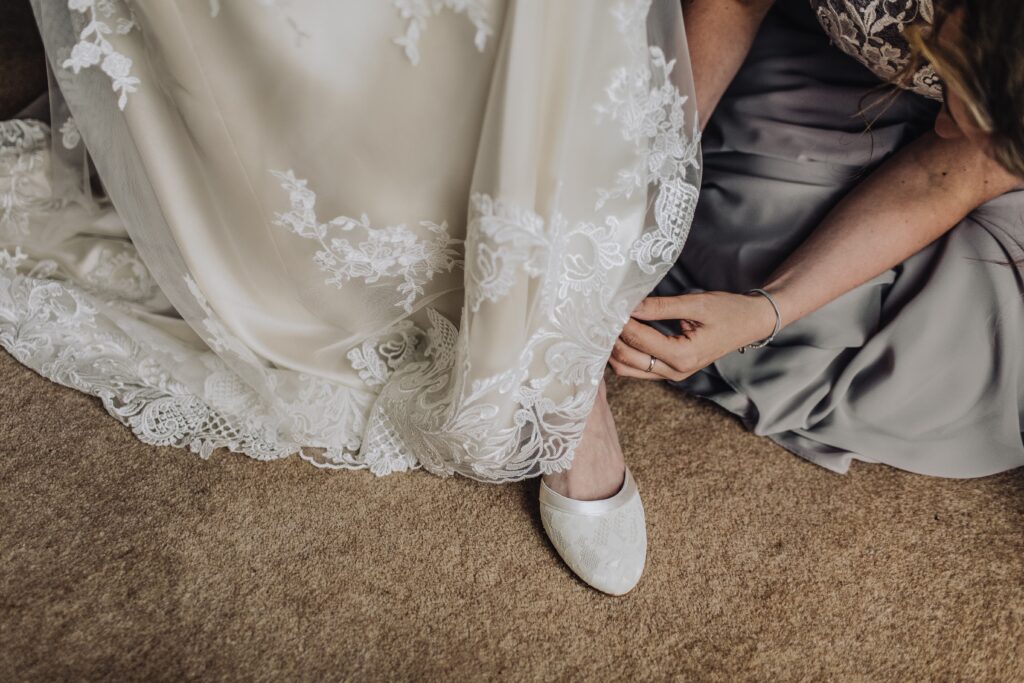
sew a hem
Heming is a great way to shorten shirts, dresses and pants that are too long. Hems also hold our clothing together, so they’re very important measures of a garment’s durability (you’ll notice them most on pants).
A hem always consists of the same three parts: An edge, hem line, and hem allowance.
directions:
- Iron the garment you wish to hem to remove any bumps or creases.
- Measure the hem line (this is best done by wearing the garment, standing in front of a mirror, and deciding where you’d like the new hem to fall. Mark the points with chalk or pins.
- Trim the fabric to a suitable length below the pin or chalk line you created. There should be enough fabric left to accommodate the hem depth. Ex: You want a 1 inch deep hem, so leave 1 inch of fabric below the hemline. This will ensure nothing looks bulky.
- Fold the hem. You can make a single fold along the hemline, wrong side to wrong side. The wrong side is the “inside” of the garment (aka the side you don’t see).
- Choose your stitch pattern. A whipstitch is good if you don’t have a lot of time, but it’s the least durable. A catch stitch is good for elasticity and strength. It’s a slight crisscross effect on the wrong side, nearly invisible on the right side. A slip stitch hem is best for near invisibility. Last but not least, a fell stitch is best for durability. Check below to learn how to do all of these stitches individually.
- Now sew the hem by measuring and cutting your thread. The length you use depends on the circumference of the hem, but it’s always better to have too much thread than too little. Generally, try to use around 18 inches (46 cm), or an arm-length of thread. Also, choose a thread color that matches the garment’s color.
- Thread a small needle and tie a knot at the other end of the thread. Turn your garment wrong-side out. Work with the hemline facing towards you.
- Start with a tiny stitch at the seam line on the wrong side of the hem. You’re bringing the needle up from behind the upper edge of the hem fold. Do not pass this stitch through to the right side of the garment.
- Make your stitch pattern. Keep stitching around, working from right to left, or left to right. Make small, evenly-spaced stitches.
- Knot the thread at the end of stitching the hem. Make a small stitch twice in the same place on the edge of the hem fold as your first stitch, but for this last stitch, do not pull the thread all the way through. Pass the needle through the loop twice, then tighten the knot by pulling on the thread.
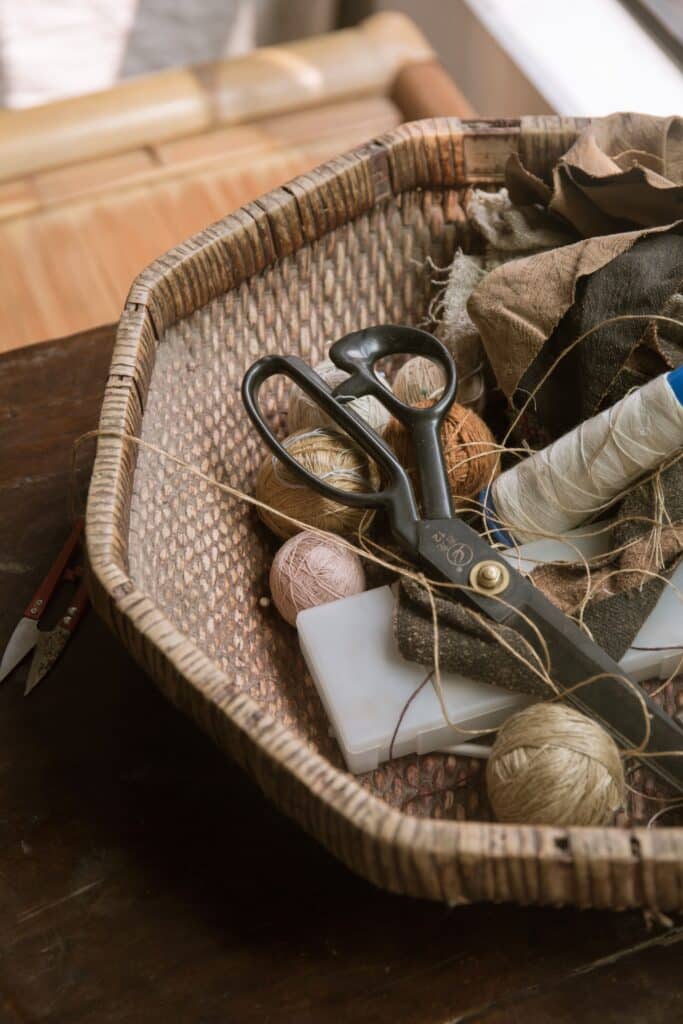
choose your stitch pattern:
Step 5 in the tutorial above asks you to choose a stitch pattern. Here are the ones I listed and how to do them in detail. Choose whichever best suits your needs.
whipstitch:
- Hide your thread knot and bring the thread from the inside through the outside of the hem fold.
- Moving from right to left (or left to right if you’re left-handed), cross over diagonally and pick up a few threads of the fabric above the fold. Keep the needle pointed in the direction in which you’re working.
- Bring the needle back out through the fold and repeat.
catch stitch:
- Hide the knot by pulling the needle outwards through the fold.
- Point the needle in the opposite direction from the one in which you’re working. Pick up a few threads of the fabric just above the hem and pull through.
- Now pick up a bit of fabric from the hem and pull through, with the needle still facing in the opposite direction, and repeat.
slip stitch:
- Hide the knot by pulling the needle outwards through hem, right at the very edge of the fabric.
- In the fabric just above the hem, pick up a few threads and pull the needle through.
- Reinsert the needle into the edge of the fold, just below where the previous stitch ended. Pull it through the edge of the hem about 1/4 inches (7mm), as if you were pulling it through a tube of fabric, and then outwards.
- Repeat the first three steps.
fell stitch:
- Hide the knot by passing the needle outward through the upper edge of the hem fold.
- Pass the needle through the fabric above the hem edge, about 1/4-1/2 inch (6-13 mm) long. Complete the stitch by passing the needle through a few threads of the top of the hem fold.
- Start your next stitch in the fabric right above the end of the previous one and repeat.
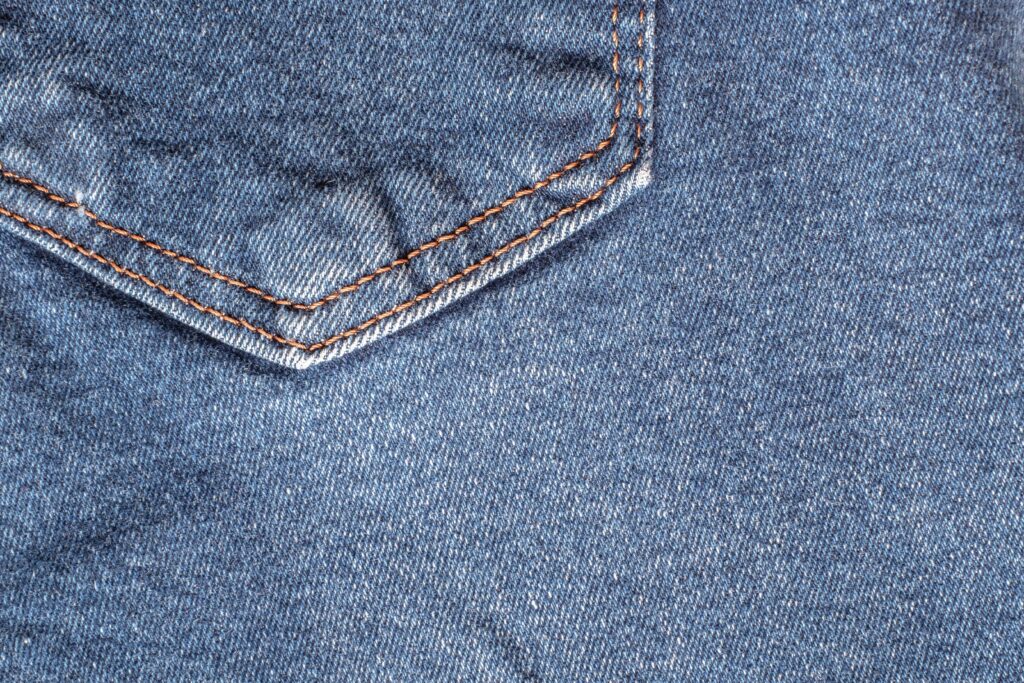
fix a seam
Do you have a ripped seam? Here’s what you’ll need to repair it.
materials needed:
- Ripped garment
- Seam Ripper
- Scissors
- Pins
- Needle
- Matching thread
- Iron
directions:
- Turn your garment inside out and inspect the ripped seam. Note where the ripped seam begins and ends. This will be where you need to resew the seam to repair it.
- If there are any loose stitches, use your seam ripper to remove them. Just gently guide the sharp end of your seam ripper under a stitch and pull upward.
- Tie any loose threads you have. Use your scissors to cut right above the knot to get rid of excess thread. Repeat on the other side of the ripped seam.
- Using sewing pins, pin the two pieces of fabric together where the seam ripped. You could also press with the iron to get the fabric to lay straight, but this is optional.
- Take your needle and thread it. Knot the end of the thread and snip the extra thread under it off with scissors.
- Insert the needle into the fabric about ½” before the beginning of the ripped seam. Use a straight stitch or a backstitch to begin sewing another seam. Be sure not to make your stitches too long or you may be able to still see a hole in the seam when you wear it.
- Use the straight or backstitch along the entire ripped seam until you’ve reached the end. Then continue making stitches about ½” into the existing seam to secure it. Make sure to knot the thread and snip off any extra thread after your final stitch. Don’t forget to turn the garment inside out and review your work before wearing.

reattach a strap
Have a spaghetti strap that broke off? Here’s how to reattach it and save your tank tops and dresses!
directions:
- First, find the place where the strap has come loose from. That’s where you’ll need to feed the end of the strap back through the hole. If this is difficult, use a safety pin to help guide the strap back through the hole.
- Once it’s through to the inside of the garment, you can use the safety pin to pin the strap in place so that it doesn’t move while you’re stitching.
- Check the length of the straps once you’ve pinned them to make sure they’re going to be the same length. If not, adjust the pin so they will be the same length before you start stitching.
- Use a back stitch to secure the strap in place. Come up from the back with your thread and bring the needle back towards yourself, go into the fabric, and then bring the needle up ahead of where the thread is coming out. Go back and forward right at the beginning of the previous stitch.
- Lift up the facing to access the area you need to stitch the strap down. Take a piece of thread no longer than the length of your arm, thread your needle, tie a knot at the end, and do your back stitch across the line of stitching that was broken and through the strap as well.
- When you’ve gone far enough, turn it around and go back over those stitches again. Take a couple of very small stitches in place to secure the end. Trim off your threads and you’re done.

replace a drawstring
Did your drawstring fall out of your sweatpants? No need to replace the whole thing. Here’s how to repair it.
FYI, if your drawstrings come out during the wash, try tying a knot at the end of each string. This will typically prevent it from coming out.
directions:
- All you need is a safety pin. Put the pin through the string near one end and pin it shut.
- Now, put your pin into the hole where the drawstring goes.
- Gently feed it through and then milk it along until it comes out the other side. Pull it through the opposite hole and there you go. Remove the pin and wear.

patch a hole
Have a hole in your favorite pair of jeans? Here’s how to quite literally, patch it up.
directions:
- Lay your garment on a flat surface with the hole facing up.
- Grab a piece of scrap fabric that is cut to a size larger than the hole. Cut the edges of the patch in to a circular shape with fabric scissors to prevent edges from fraying. Insert the patch to the underside of the hole and pin into place.
- Thread a needle in a matching color and sew slip stitches around the perimeter of the patch.
- Turn your piece right side out. Reinforce the stitching with smaller hand stitches and then remove the basting stitches. Feel free to take this to a sewing machine as well. Rows of straight stitches work great, but you can also do zig zag if you prefer. And that’s it!
So, are you ready to show your friends how to sew a button now? Which of these mending tutorials was your favorite? Let me know in the comments!













